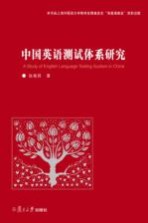

中国英语测试体系研究PDF电子书下载
- 电子书积分:10 积分如何计算积分?
- 作 者:张艳莉著
- 出 版 社:上海:复旦大学出版社
- 出版年份:2010
- ISBN:9787309071887
- 页数:246 页
Chapter 1 Introduction 1
1.1 Educational Background 1
1.1.1 The Streamline Approach(SA) 2
1.1.2 Efforts Made under SA in China 3
1.1.3 From the Teaching Syllabuses to the Curricular Standard 4
1.2 Language Teaching and Testing 7
1.2.1 Strevens'Model 7
1.2.2 Clarification of Some Terms 9
1.2.3 Testing Purposes 10
1.2.4 Washback&Impact 13
1.3 The Status Quo of Language Teaching and Testing in Chinese Schools 16
1.3.1 The Research Background 17
1.3.2 Problems and Reflections 18
1.3.3 Introduction of Some "State-of-the-art" EFL Graded Tests 26
1.3.3.1 The Public English Test System(PETS) 27
1.3.3.2 The Cambridge Young Learners English Tests(CYLET) 29
1.3.3.3 The English Graded Tests in Shanghai(EGT) 30
1.3.4 Comments on the Three Testing Provisions 32
1.4 Purpose and Scope of the Present Study 33
1.5 Layout of the Book 35
1.6 Summary 37
Chapter 2 Theoretical Explorations and Literature Review 39
2.1 Introduction 39
2.2 Variables in SLA 40
2.2.1 Natural Route and Natural Rate 40
2.2.2 Affective Variables 41
2.2.3 Age Effects upon SLA 43
2.2.4 The Critical Period Hypothesis(CPH) 44
2.3 From Language Performance(LP)to Communicative Competence(CC) 46
2.3.1 A Historical Sketch of CC 47
2.3.1.1 Distinction between Competence and Performance 47
2.3.1.2 Skills and Components Models of LP 48
2.3.1.3 Hymes'Model of CC 49
2.3.1.4 Others'Understanding of CC 50
2.3.1.5 Canale and Swain's Model of CC 51
2.3.2 Bachman's(1990)and Bachman&Palmer's(1996)Models 52
2.4 Variations in Language Testing 58
2.4.1 Test Takers'Variables 58
2.4.1.1 Demographic Data/Personal Characteristics 59
2.4.1.2 Knowledge Schemata 59
2.4.1.3 Affective Schemata 60
2.4.1.4 Cognitive and Metacognitive Skills 61
2.4.2 Test Method/Task Variables 61
2.4.2.1 Setting or Testing Environment 64
2.4.2.2 Test Rubric 64
2.4.2.3 Input 65
2.4.2.4 Expected Response 65
2.4.2.5 Relationship between Input and Response 66
2.5 Scoring Issues 68
2.5.1 Categories of Scoring:Holistic&Analytic 69
2.5.2 Criterion-referencing(CR)and Norm-referencing(NR) 70
2.6 Summary 71
Chapter 3 Rationale for the SETS Framework 73
3.1 Introduction 73
3.2 Characteristics of Adolescent Language Learners 74
3.2.1 Cognitive Differences among Children,Adolescents and Adults 74
3.2.2 Theoretical Perspectives about Adolescent Thinking 76
3.2.2.1 Piagetian Perspective 76
3.2.2.2 Information-processing Perspective 77
3.2.3 Personality Development Perspective 78
3.2.4 Universals of and Particulars over Adolescence 80
3.2.4.1 Commonalities of Adolescents 80
3.2.4.2 Psychosocial Development of the Three Boundaries of Adolescence 82
3.3 An Overview of the Streamline English Testing System(SETS) 85
3.3.1 Characteristics of Chinese School Students 85
3.3.2 A Sketch of the National English Curricular Standard(NECS) 86
3.3.3 Bases and Characteristics of the SETS Framework 91
3.4 General Principles Governing the SETS Framework 93
3.4.1 An Overview of the Test Development 93
3.4.2 General Guidelines for the SETS Framework 95
3.5 Summary 112
Chapter 4 Operationalization of the SETS Framework 115
4.1 Introduction 115
4.2 Description of the 3-phase Overall Framework 116
4.2.1 The General Framework of the SETS 116
4.2.2 Detailed Descriptions of the Construction Procedures 120
4.3 Speaking 133
4.3.1 The SETS Subframework for Testing of Speaking 133
4.3.2 Discussions 140
4.3.3 Sample Speaking Tasks 144
4.4 Listening 146
4.4.1 The SETS Subframework for Testing of Listening 146
4.4.2 Discussions 151
4.4.3 Sample Listening Tasks 153
4.5 Reading 157
4.5.1 The SETS Subframework for Testing of Reading 157
4.5.2 Discussions 163
4.5.3 Sample Reading Tasks 166
4.6 Wriring 171
4.6.1 The SETS Subframework for Testing of Writing 171
4.6.2 Discussions 177
4.6.3 Sample Writing Tasks 180
4.7 Grammar and Vocabulary 184
4.7.1 The SETS Subframework for Testing of Grammar and Vocabulary 184
4.7.2 Discussions 190
4.7.3 Sample Test Tasks 192
4.8 Summary 197
Chapter 5 Conclusion and Recommendations 199
5.1 Introduction 199
5.2 Recapitulation 200
5.3 Evaluation of the Present Study 202
5.3.1 Limitations of the Study 202
5.3.2 Recommendations 204
5.3.2.1 Establishing a Two-tied Assessment Scheme 204
5.3.2.2 Integration with Tests in Colleges 205
5.4 Summary 206
Bibliography 208
Appendix 1 A Questionnaire 221
Appendix 2 The Questionnaire Takers 225
Appendix 3 The National English Curricular Standard 227
- 《红色旅游的社会效应研究》吴春焕著 2019
- 《汉语词汇知识与习得研究》邢红兵主编 2019
- 《生物质甘油共气化制氢基础研究》赵丽霞 2019
- 《东北民歌文化研究及艺术探析》(中国)杨清波 2019
- 《联吡啶基钌光敏染料的结构与性能的理论研究》李明霞 2019
- 《异质性条件下技术创新最优市场结构研究 以中国高技术产业为例》千慧雄 2019
- 《《国语》和《战国策》词汇比较研究》陈长书著 2017
- 《中国制造业绿色供应链发展研究报告》中国电子信息产业发展研究院 2019
- 《行政保留研究》门中敬著 2019
- 《新课标背景下英语教学理论与教学活动研究》应丽君 2018
- 《妈妈365天英语》(韩)申艺莉著 2014
- 《少年国王》(英)O.王尔德(O.Wilde)原著;(英)D.K.斯旺(D.K.Swan),(英)M.韦斯特(M.West);张艳敏翻译 2015
- 《王充儒道思想评价》颜莉著 2020
- 《全国大学生英语竞赛B类(英语专业) 综合指南与高分突破》赵晓敏,张艳霜著 2018
- 《音乐基础-乐理与视唱练耳》张艳群主编;杨娅,刘莉莉副主编;贺智慧,阮航,艾珺参编 2019
- 《良渚文化》罗晓群,黄莉著 2019
- 《中国文化消费水平提升问题研究》高莉莉著 2019
- 《中职国家规划配套教材 我的大学记忆 江西师范大学国际教育学院纪事》张艳国 2019
- 《将来的你,一定会感谢现在拼命的自己》张艳玲 2018
- 《老年大学声乐教育研究》唐冰莉著 2018
